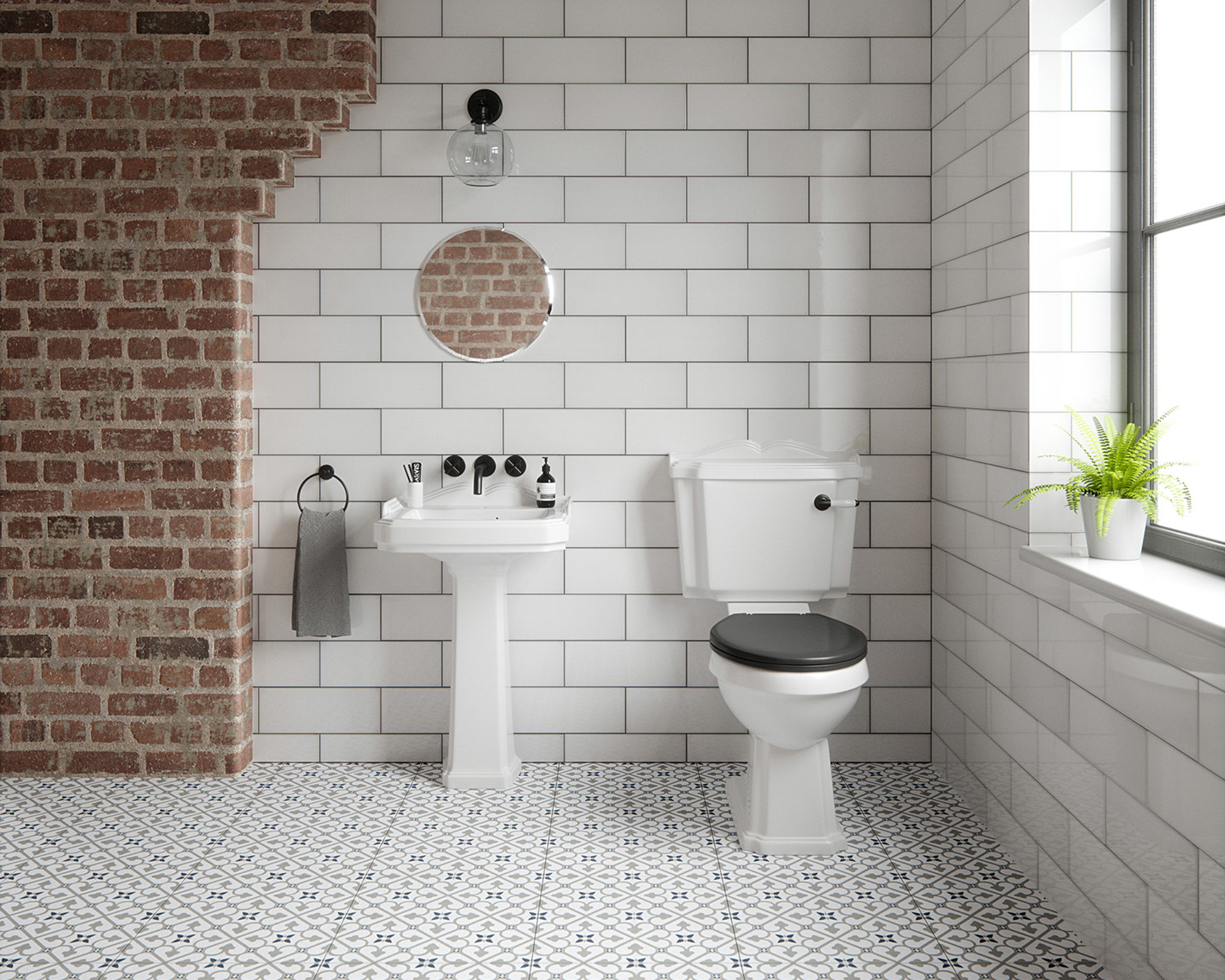Painting tiles: expert DIY advice on how to paint tiles easily
Discover how painting tiles can give your kitchen or bathroom space a clean new look – tile painting is easy, effective and affordable


Painting tiles can dramatically cut the cost of renovating a tired looking bathroom or even kitchen – and with our handy step-by-step guide to painting tiles, you can put this quick and cost-effective solution to the test in your own home.
Whether you've inherited a dated scheme or are in search of a weekend project that will transform a space, painting over tiles could be your solution. Here, we've covered everything from one-toned tiles to achieving an on-trend patterned finish with nothing more than stencils, paint and a bit of patience – whether you use one of the best paints for kitchens or the best bathroom paints.
Looking for more bathroom ideas and inspiration? You'll find loads of lovely looks over in our gallery.
How do you paint over tiles?
You can paint over tiles yourself, whether they are porcelain, ceramic or glass. You just need to equip yourself with the right tile paint, tools and equipment which we have listed below in our everything you need section.
Then, follow the sections from our suggested methods, choosing the steps that most apply to your existing tiles, their current condition, and of course, consider the type of painted tile effect you are trying to achieve in your kitchen, bathroom or other area of your home.
Painting tiles: everything you need
- B&Q Concentrated sugar soap (or a similar detergent)
- Scourer
- Wilko Fungicidal spray (or similar)
- Ronseal Hairline Crack Wall Filler from Homebase (or similar)
- Diall Fine-grade sandpaper from B&Q (or similar)
- Gloves
- Small paint brush
- Dulux Primer (or similar)
- Ronseal One Coat Tile paint from Amazon (or a high-gloss solvent-based paint)
1. Choose the right tiles to paint
Painting over tiles may be a quick, affordable way to update a room, but it is not the most durable solution; if anything, it's more of a stop-gap.
To avoid the paint peeling quickly, opt for areas that aren’t subject to much drenching - avoid showers or areas directly behind the sink, for example.
Get small space home decor ideas, celeb inspiration, DIY tips and more, straight to your inbox!
2. Clean the tiles thoroughly
Top Tiling Tip
If the grout is in poor condition, scrape it out and re-grout before painting. Same goes for any hairline cracks. Use an epoxy glue on smaller cracks to create an even surface. Taking the time to do this will give the best finish.
Making sure the tiles are clean before you even pick up a brush is key. Dirt, dust and grease can stop the paint from adhering properly, so spend some time cleaning the tiles with sugar soap or a detergent solution and a scourer. If you are painting kitchen tiles be very thorough with this step, because they are likely to be greasy or have food residue on them that you will see through the paint.
If there are any mold stains on the grouting or sealant, use a fungicidal spray to kill it off before applying any paint. A steam cleaner is also very effective for cleaning grout and tiles. Browse our pick of the best steam cleaners to make sure you've got the best tools for the job. Ensure the tiles are completely dry before starting to paint (we recommend waiting 24 hours).
3. Sand the tiles
When painting a high-gloss tile, lightly sand the area to give the paint something to adhere to, just be sure to clean off any dust before you start tile painting.
4. Choose stencils for an on-trend patterned finish
If you're looking to achieve an on-trend patterned tile for a fraction of the price, you might consider painting over existing tiles with the help of a stencil. It's easier than you might think, we promise.
The Zarzis Star Tile Stencil for Painting, available from Etsy, is one of our favorites; make sure to pick the right sized stencil for your tiles and consider your color palette carefully. You can't go wrong with neutrals.

Amazon also stock some lovely floor tile stencils, as do Etsy – or there are more below for you to choose whether you're painting kitchen tiles or bathroom tiles. Just be sure to pick a size that fits nicely on your current tiles. Stick the stencils to the tile and then create the pattern using a small brush or a sponge.
5. Shop for the right paint for tiles
Successful results rely on choosing the right, high-quality paint, with specific tile paints being the best choice. We'd recommend trying Ronseal One Coat Tile Paint, sold at B&Q, and Dulux Tile Paint from Homebase; the majority of these specialist paints won’t need a primer, but always follow the manufacturer's instructions.
Tile paint color options can be limited, so if you want a particular shade, prime tiles with a high-quality, solvent-based primer such as the Dulux Professional White Undercoat, and use a high-gloss or semi-gloss paint for your top coats. Be sure to check out our bathroom paint colors page for inspiration.
6. Prime your tiles (if necessary)
For all tile painting jobs you should check if this is a necessary step to ensure the longevity of your tiles' look. If you are using a primer, a small brush is the best choice for the job as it’s hard to get into the grouting with a roller. Be aware that painting tiles is unforgiving and brush strokes will show easily, so keep your coats thin. Let the primer dry completely and then lightly sand to ensure the paint adheres to the surface. Remove any dust before starting on your topcoat.
7. Begin painting the tiles
Once the primer is completely dry, use a similar sized brush to start painting on your color. If you're using a stencil this is the time to position it on your first tile – take your time to ensure it's in the right position.
Apply several thin coats to avoid heavy brush marks showing through and to ensure the paint doesn’t peel after just a few weeks.
Two coats will usually be required, but if you are painting over a dark colored or patterned tile you may require more. Be aware that if you are painting tiles with a raised pattern this will still show. Allow the paint to dry thoroughly between each layer.
8. Expert advice for an on-trend, patterned finish to your tiles
Use your stencil to tackle one tile at a time, ensuring precision and making sure that everything is aligned as it should be. Our pro tips will help you achieve the desired finish:
- Less is more when it comes to tile painting. Ensure you're only dipping the very end of your paintbrush in the paint to prevent overloading, and wipe away any excess. If your stencil is bleeding, this is a sign that there's too much paint.
- You might also consider using a sponge, rather than a brush. This generally prevents you from using too much paint, and makes it easier to cover a large area in a short amount of time.
- Practice using your stencil on a spare tile or paper plate. It can take a few attempts to master the technique, so make sure you know what you're doing before tackling your tiles.
- Start with a less visible tile and only tackle those in the middle when you're confident you know what you're doing.

9. Tile painting requires patience – let the paint dry
Allow the paint to dry for at least 24 hours – or for the time stated by your chosen paint's manufacturer.
Tips for how to paint bathroom tiles
- Try to remove any silicone sealant from around showers, baths and sinks before painting and re-seal when the painting is complete. If you can’t remove the sealant, make sure it is properly masked off as paint will never properly adhere to it.
- Once you have painted your tiles do not attempt to re-grout – do this step before, as anything abrasive will remove the paint.
- Avoid abrasive cleaning products after painting tiles as it will remove the paint.
Tips on how to paint kitchen tiles
- Clean them thoroughly, making sure any grease or food stains are completely removed
- Use grout cleaner and a microfiber cloth to get rid of any food or grease that has got in between the tiles
- Before you start painting kitchen tiles, protect any worktops with dust sheets and masking tape

Hebe joined the Real Homes team in early 2018 as Staff Writer before moving to the Livingetc team in 2021 where she took on a role as Digital Editor. She loves boho and 70's style and is a big fan of Instagram as a source of interiors inspiration. When she isn't writing about interiors, she is renovating her own spaces – be it wallpapering a hallway, painting kitchen cupboards or converting a van.